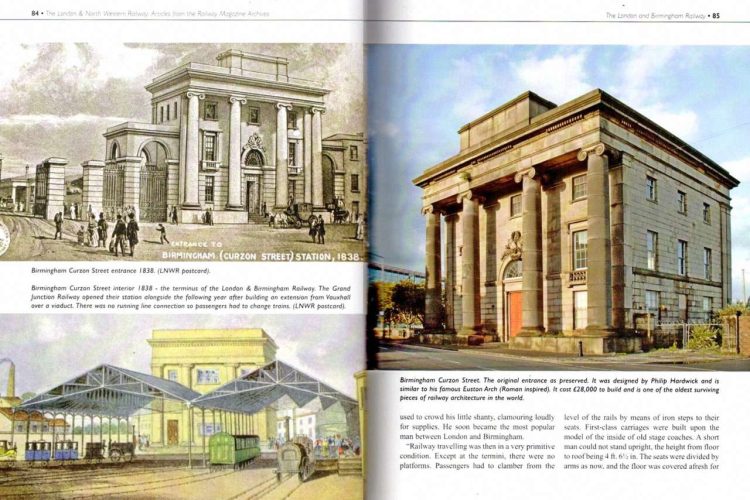Published in May 2021, this book from publishers Pen & Sword is an immensely readable selection of articles taken from the Railway Magazine archives about the London and North Western Railway (LNWR) around the start of the 20th century.
Edited by Neil Smith, this hardback book measures around 290 cm x 220 cm, has 304 pages and 205 colour and black and white illustrations. It has a published price of £35.00, but at the time of writing it can be obtained from Amazon for £24.73. The book's full title is The London & North Western Railway, Articles from the Railway Magazine archives, the Victorian era and the early 20th-Century.
Neil Smith is to be commended for his excellent choice of articles that fill 27 chapters, each being a reproduction of an article about the LNWR that was published in the Railway Magazine between August 1897 and April 1904.
There are revealing interviews with C.J. Bowen Cooke, District Locomotive Superintendent of the LNWR, who describes the role of engine drivers and their duties, Frederick Harrison, General Manager of the LNWR, who provides interesting insights into how the LNWR is seeking to expand its business, and F.W. Webb, the LNWR's Chief Mechanical Engineer, who describes the more technical aspects of the company's locomotives.
The variety of trains to be seen 120 years ago is exemplified by a series of chapters on notable railway stations, with Birmingham New Street, Carlisle Citadel, Euston, Manchester London Road (now Piccadilly), and Preston featured.
Chapter 3 describing 24 hours at Willesden Junction is an eye-opener. The station's role has changed so comprehensively since its original publication in September 1897, when Willesden was both a major interchange and a ‘ticket' station, at which passengers' tickets were collected before they reached the terminus at Euston, a function that disappeared following the widespread introduction of corridor trains.
Surprisingly, the USA features in two articles, with an account of LNWR rolling stock that travelled to the United States for the Chicago International Exhibition of 1893, whilst Chapter 5 describes a trip on the seemingly secretive “American Special” trains that ran in connection with transatlantic ships from White Star Line and Cunard to New York. The train ran non-stop from Euston to Edge Hill in Liverpool, where a couple of 0-6-0 tank engines took over for the short distance to Riverside station, conveniently placed for transfer to the ships.
Crewe merits two chapters, one describing its evolution into the celebrated railway town, the other how it became a virtual ghost town during the annual Crewe Works holiday week. As well as Crewe Works, other railway establishments featured include Wolverton Carriage Works and Earlestown Wagon Works.
Whilst the LNWR did not have its own route to Sheffield, it did have running rights over the Grand Central. To accommodate freight that exercised those running rights, it built a new goods warehouse in the city. To service the warehouse, the company laid a short line, barely three-quarters of a mile long, giving the LNWR its own line separated by about 30 miles from the nearest point on its own network.
Articles on specific routes and trains include journeys on the Irish Mail, the Liverpool Express, LNWR cross country services, and London to Birmingham express train services. Further articles describe the opening and early years of the LNWR's constituent companies, including the Liverpool & Manchester Railway, London & Birmingham Railway, and the Grand Junction Railway. Equally interesting is a description of an LNWR route to Manchester via Ashbourne, through the heart of Midland Railway territory.
Completing the volume are chapters on LNWR rolling stock including Precedent and Webb Compound locomotives, and Royal Saloons.
These pages show Curzon Street station in Birmingham. Never in their wildest dreams could the directors of the LNWR have imagined that 130 years after it closed to passengers, it would be resurrected as the Birmingham station for Britain's new high-speed railway, HS2.

The photos on the left are taken from the article about the LNWR's incursion into Midland Railway territory to reach Manchester via a branch to Ashbourne.
No book about the LNWR would be complete without a photo of Euston station's iconic Doric arch, shamelessly destroyed when the station was rebuilt in the 1960s.
The article of F.W. Webb includes a fine selection of photos illustrating some of his locomotive designs.
This book is a wonderful miscellany of the London & North Western Railway drawn from the Railway Magazine archives between the close of the Victorian era and the start of the 20th century. The large number of photographs and illustrations, mostly from the archives of the London & North Western Railway Society, make this a very special book.
The book is available to purchase from Amazon and from Pen & Sword.
We would like to thank Pen & Sword for providing RailAdvent with a copy of the book for review.